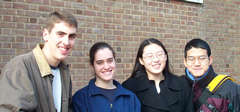| enginuity |
|
home | contents | previous | next |
Bridging the Atlantic
In July 2000 the University signed an agreement with the Massachusetts Institute of Technology(MIT) to form the Cambridge MIT Institute (CMI). The primary goal of CMI is to undertake joint educational and research initiatives that will improve entrepreneurship, productivity and competitiveness in the UK. Four students of Mechanical Engineering from MIT flew to Cambridge in October 2000, to become the first students taking advantage of the exchange scheme offered by the CMI. On arrival they enrolled in the third year of the Engineering Tripos. The students were chosen on the basis of their 'academic achievement and maturity': they needed to be far enough ahead on their own course to be able to handle a year away without falling behind.
The Engineering degree course at MIT is structured quite differently to the one in Cambridge, in that it is totally modular, and relies on coursework assessed on an on-going basis. "In the States there is far less standardisation in terms of academic attainment at high school than in this country. We don't have the national standardisation given by your A-level system," explains Gina. "This means that students enrolling for an engineering degree may have quite diverse starting points. The educational system in the USA allows for this diversity, in that you can choose appropriate modules to bring you up to speed. You can also take as many or as few as you like (within reason) in each year, which means that students of high ability and who have been educated to a high standard before they start the course can go through in a shorter time."

The first students from MIT:(left to right) Kevin Lang (Corpus Christi), KristenClements(Queens'), Gina Kim (Jesus) and Linus Park (St John's).
For the four students who have come to Cambridge for their third year, the course structure was pre-determined, as there were only certain courses that would be appropriate for them. "We can only get credits for six classes in our year here, whereas at MIT we could have taken eight. That is why we had to be already ahead in order to come."
So how are the visitors finding things on this side of the Atlantic, having chosen a year when more rain has fallen than ever before and the trains don't work and the fog has rolled in...?
"That's what we expected England to be like, so we are not as surprised by it as people who live here!" they say. All four agree that the opportunity to work abroad and get a global perspective has been invaluable. "There are many cultural differences between the UK and the USA. It is so easy to make stereotypical judgements, based on what you see on TV."
The Department of Engineering has taken a lead in negotiating the changes required in the University statutes to allow Cambridge Undergraduates to take advantage of the exchange scheme. In the academic year 2001 to 2002 there will be 15 places for those who would normally be studying either Part IIA of the Engineering Tripos or Part I of the Electrical and Information Sciences Tripos to spend the academic year at MIT. Cambridge students taking part in this exchange will return to the UK with an MIT transcript with details of their course grades and be able the following year to continue with part IIB of the Engineering Tripos or Part II of EIST just as if they had remained in Cambridge for their third year except that that will not have a 'class' at the end of year 3.
| number 10, June 2001 | home | contents | previous | next |